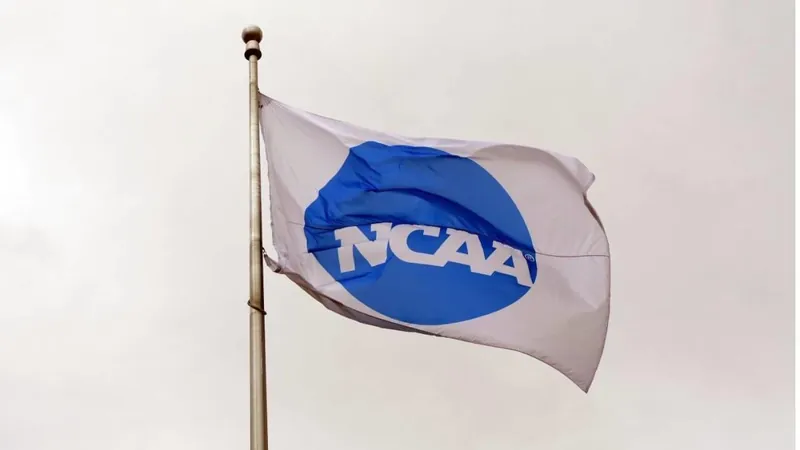
The High-Stakes Battle of House v. NCAA: What You Need to Know Before Settlement Hearing
2025-04-06
Author: Ling
Overview of House v. NCAA
In the realm of college sports, few legal battles have garnered as much attention as the House v. NCAA case, which is poised to make history as a pivotal moment for athletes' rights. This case is not just another legal dispute; it marks a dramatic turning point in the longstanding struggle for fair compensation and rights for college athletes.
Proposed Settlement Details
The crux of the case revolves around the proposed settlement that could upend the existing dynamics of collegiate athletics. According to players' rights advocate Ramogi Huma, 'This settlement is unworkable. The schools are beginning to find that out.' Many skeptics fear that the establishment of the House settlement could ultimately fracture college sports, rather than unify them.
One of the settlement's main features is the proposed $20.5 million annual cap on revenue-sharing models that would distribute funds across various sports. However, states like Colorado and Nebraska have already legalized uncapped payments for athletes, leading to potential conflicts with NCAA regulations. As the landscape evolves, a major question lingers: Could this settlement fail and unleash a flurry of additional lawsuits?
Historical Context of College Athletes' Rights
Historically, college athletes were confined under the NCAA's stringent rules about amateurism, which limited compensation to scholarships covering tuition, room, and board. But the tides began to shift with the introduction of Name, Image, and Likeness (NIL) legislation, starting with California's groundbreaking bill in 2019. California's law changed the narrative, preventing the NCAA from punishing schools for entering NIL deals and effectively dismantling its authoritative grip on colleges across the nation.
The Supreme Court’s unanimous decision in the Alston case further compounded the NCAA's challenges. The justices declared, 'The NCAA is not above the law,' a message that reverberated throughout the sports industry. With this decision and ongoing legal battles, the House v. NCAA case emerged, filed by athletes Grant House and Sedona Prince as a bold move to dismantle outdated NCAA restrictions on revenue sharing.
Concerns About the Settlement
Under the currently proposed settlement, all NIL deals exceeding $600 would require review, creating speculation about the volume of deals that fall under this threshold. Concerns also arise regarding the definition of 'fair market value' in a rapidly evolving NIL market rife with discrepancies.
While NCAA president Charlie Baker champions the settlement as a temporary fix aimed at maintaining a connection to education, critics have voiced their concerns about the lack of representation for players during the negotiations. In fact, Huma argues that 'after 10 years of litigation, we find ourselves in a position where, despite billions in payouts, there will be more restrictions than initially imposed.'
Debates Surrounding Roster Caps and Scholarships
The settlement has numerous components that ignite further debate. For instance, roster caps for sports like football have been introduced, with limits on total team sizes, potentially impacting long-standing traditions regarding walk-on players. Moreover, with most scholarships now designated as equivalency awards, the opportunity for complete scholarships is diminished, raising further questions about equity in college athletics.
Upcoming Settlement Hearing
As we approach the critical Monday hearing, overseen by Judge Claudia Wilken, the anxiety surrounding the approval of the settlement is palpable. Though it’s widely anticipated that Wilken will approve the settlement, any objections raised could impact the entire process. Interestingly enough, athletes like LSU gymnast Livvy Dunne and Utah swimmer Gannon Flynn plan to voice their concerns, including issues of gender equity and the ramifications of roster limitations.
Potential Outcomes and Implications
If the settlement is rejected, all court eyes may turn back toward a potential trial, where the NCAA could face even harsher repercussions, including astronomical damages that might threaten its very existence.
The aftermath of this upcoming hearing could very well shape the future of college athletics as we know it. With the current trajectory pointing toward an influx of new lawsuits concerning various contentious elements of the settlement, it remains uncertain what the true impact of House v. NCAA will reveal in a system that desperately needs reform.
Stay tuned to find out how this dramatic legal saga unfolds—college sports may never be the same again!


 Brasil (PT)
Brasil (PT)
 Canada (EN)
Canada (EN)
 Chile (ES)
Chile (ES)
 Česko (CS)
Česko (CS)
 대한민국 (KO)
대한민국 (KO)
 España (ES)
España (ES)
 France (FR)
France (FR)
 Hong Kong (EN)
Hong Kong (EN)
 Italia (IT)
Italia (IT)
 日本 (JA)
日本 (JA)
 Magyarország (HU)
Magyarország (HU)
 Norge (NO)
Norge (NO)
 Polska (PL)
Polska (PL)
 Schweiz (DE)
Schweiz (DE)
 Singapore (EN)
Singapore (EN)
 Sverige (SV)
Sverige (SV)
 Suomi (FI)
Suomi (FI)
 Türkiye (TR)
Türkiye (TR)
 الإمارات العربية المتحدة (AR)
الإمارات العربية المتحدة (AR)